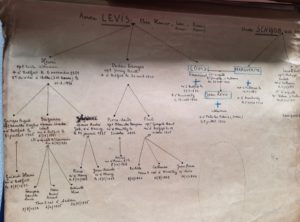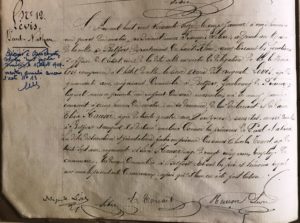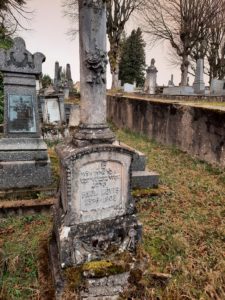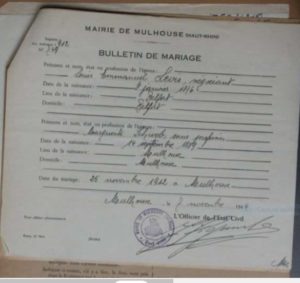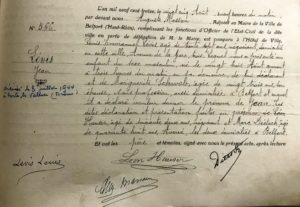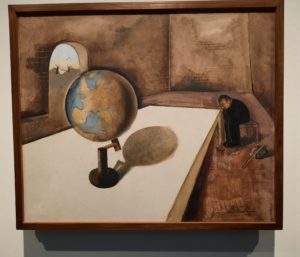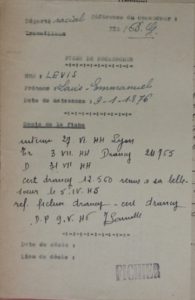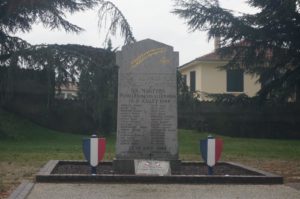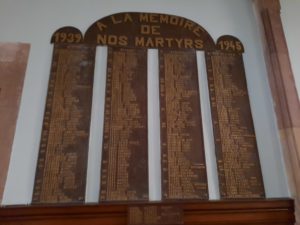Louis LEVIS (1876 -1944)
LOUIS LEVIS’S FAMILY : BEING ORDINARY FRENCH CITIZENS
Louis’s father (Aron called Auguste Levis) was born in 1834 in Saverne, Alsace and died in 1883 in Belfort.
Auguste’s father, Nathan, was also born in Saverne (1796) but he got married to a woman from Belfort, whose name was Rebecca Hauser. The Hauser family was one of the biggest Jewish family in Belfort.
Nathan used to be a haberdasher in Belfort, then came back to Saverne to become a primary school teacher.
Aron called Auguste had siblings : three sisters and two brothers . He was a textile merchant in Belfort and also got married to a woman from Belfort. His wife, Elisa Hauser, was a housewife, like most women at that time.
The dearest wish of the family was to become ordinary French citizens.
The Jewish community was allowed to settle in Belfort from 1791. They lived mainly in the old town.
Before 1791, Jewish people were not allowed to have a professionnal activity. They were not regarded as full citizens. They were only allowed either to be peddlers, – going from village to village and town to town to sell second-hand goods – or to sell a few animals. They could not be landowners. From 1791, thanks to the French Revolution, they became full citizens.
Why getting married to a Jewish girl from Belfort ?
At that time, young people were encouraged to get married to young people from Alsace, which had a much more developped Jewish community. It was also linked to the development of the textile industry in Belfort, which became stronger.
The issue was to let the small Jewish community of Belfort grow: they were only 478 members in 1823.
LOUIS LEVIS – A WISE MAN AND A GOOD SOLDIER
Louis was born on January 9th 1876 at 6.30 am. Auguste Levis, his father, was 40 years old and his mother was Elise Hauser (one more Hauser) 34 years old. Louis was named Louis Emmanuel Levis. The family lived in Faubourg De France, so we suppose they were rather wealthy as the richest Jewish lived in that part of the town.
He had a twin brother : Paul Nathan was born at 5.00 pm. We have other information about him thanks to the different population census. At the beginning, we thought he died very young but on the 1901 document, we can see that he was alive and aged 21.
When we visited the Jewish graveyard, we learnt thanks to our guide, Mrs Hofnung, that Paul died prematurately at the age of 23. Was he ill or did he have an accident? We do not know.
Louis had two other brothers Henri and Georges.
Georges became a doctor and studied at the University. We assume that his parents were very proud of him. At that time, people did not go further than primary school.
Louis received an education level « three » (primary school) and Georges level five. His wife Jenny Barth, was also deported on March 12th 1944 and died in Auschwitz.
Henri was a textile merchant, had his own business, had 3 daughters and one son. Two of his children (Suzanne and Georges) helped to know more about Louis, Jean and Marguerite, after the war. Suzanne testified for Yadvashem and Georges made it possible to find out what happened to the belongings of the Levis family.
At he age of 19, Louis decided to join the army for 3 years and from 1895 lived in Saint Dié (Vosges), a small town located in a neighbouring region and 150 kms from Belfort. He was sent to an infantry regiment (3ème Bataillon de Chasseurs à pied). In 1898, he left the active army and went back to Belfort. From the 1906 census, we know that Louis and his brother were travelling salesmen.
LIFE AND HAPINESS
Louis got married to Marguerite Schwob on November 26th 1912 in Mulhouse. He was 36 years old and his wife 23. He was a brown-haired man and 1.61m tall. Like the other members of his family, he went and got married to a Jewish woman from Alsace, which at that time was German.
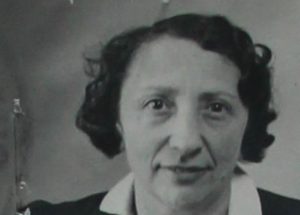
The couple lived at 3 rue (or Avenue) de la Gare (then, Avenue Wilson) in Belfort, just in front of the railway station. Louis owned half of the building. He had a close relationship with his uncle Leon Hauser, his mother’s brother. Leon Hauser also lived in the building and owned the other half.
![]()
Jean Levis, his only son, was born on August 23rd 1913 at 3.00 am. At that time, Louis was 37 and Marguerite 23. They had only one child. Was it of their own choice or did Marguerite have a health issue?
Before the First World War, Louis had decided to remain in the reserve army. He was mobilised for the 1914 war. As he was rather old, (38 years old), he joined the territorial infantry, responsible for guarding Belfort.
Those men were called «the Grandpas» In French, «les pépères». (an affectionate word!)
The war ended. Things got to normal. Louis went back to business and became a wise businessman, who knew how to diversify his assets. And he could rely on his son, Jean. The family was rather wealthy. They had servants and even possessed a car. A black Peugeot 202. Their son Jean had his driving licence in 1932 and drove the car.
How did the family live through the 1929 crisis, which for Belfort, came later, in 1931/1932 ? We do not know but a business they owned, closed down in 1932. There were many bankruptcies at that time.
HARD TIMES
Jean was mobilised on January 23rd 1940 but he was assigned to the army auxiliary service because he was not in good health. His eyesight was poor and he weighed only 53 kilos.
In Belfort, the German invasion corresponded to the beginning of difficulties for the Jews. Before the invasion, the Jews of Belfort and the surrounding area refused to admit the approaching danger. It is true that in 1940, people were not as quickly informed as today. The existence of persecutions in Germany was known but the Jews felt protected by their French nationality. But the Vichy government was deeply anti-Semitic and the French police were often overzealous.
After the defeat, censuses of the Jewish population were carried out. We were able to consult the one for Belfort. Only the name of Jean was recorded. Like many people, Louis fled the war zone with his wife, Marguerite Schwob and went to Lyon. And he could not return because the Territoire de Belfort was part of the forbidden zone. Moreover, it was very difficult to travel, especially to Switzerland or Alsace.
Consequently, Louis and Marguerite left Belfort from June 1940.
They had planned to go to Montpellier but finally settled in Lyon (in the so called Free Zone), with Marguerite’s sister and her husband. They lived near the great synagogue on Tilsit Quay. And their main address was 26 rue d’Aubercour in Lyon.
Jean was taken prisoner of war on June 21st 1940 and sent to Austria (Stalag 17A). He was repatriated on January 19th 1941. Was it because of his bad health? And he was demobilised on January 20th 1941.
Did he go to Lyon straigth away or did he stay in Belfort for a while ? We do not know. Thanks to the military record, we can notice that in 1941 he lived at 3 rue de l’Hôpital in Lyon so we suppose he was there with his parents.
Louis and his son were able to work again because in Lyon there was a large community of Jewish people and the textile industry was also developped in the city.
Life was quiet until 1942. Jean apparently had a girlfriend. He spent much time with his uncle and aunt, Mr and Mrs Michel, who had also settled in Lyon.
HELL BEGAN
The invasion of the southern zone on November 11th, 1942 resulted in the occupation of all of French territory. Jewish people were more and more persecuted and deported.
And from 1943 in Lyon, Klaus Barbie – the butcher of Lyon – persecuted the Jewish and the members of the French resistance. Life became actually more and more difficult for the Levis. They were hunted down and lived in different places to avoid being arrested
Paul Touvier was eventually appointed head of the intelligence department in the Chambéry Milice under the direction of Klaus Barbie. In January 1944 he became his second regional head.
On 13 June 1944, the French militia, with Paul Touvier at his head, entered the synagogue of Lyon and arrested all those present. Is there a link between that event and the fact that the Levis family got arrested almost a few days after ? We do not know but it is disturbing.
Jean was arrested. We have no idea about the circumstances and the date but he was taken to the Montluc prison. (many resistants were jailed and tortured in that prison)
He was shot down by the German army on July 8th 1944 in Portes les Valences, a small town close to Lyon. (under the number 9) He was killed against the wall of the station and in retaliation for a sabotage in the station.

Why was he killed ?
During the night of 6 to 7 July 1944, Paul Bernard’s Groupe Franc, from the Pons company, carried out a sabotage at Portes-lès-Valence station: shortly before midnight, explosions rang out in the depot. Eight locomotives were destroyed… A few minutes later, the administration building, where some Germans had taken refuge, was blown up and collapsed. Twelve Germans were killed and seven injured. Unfortunately, despite the instructions to evacuate the premises, three French employees of the SNCF were killed: Robert Benzo, Victor Kuhn and Gabriel Prévost. The Germans immediately retaliated: the next day, on 8th July 1944, thirty internees from the Montluc prison in Lyon, to which they added three people from the Drôme, taken at Saint-Donat on June 15th 1944, were shot down against the wall of the station. Most of them were Jewish.
Louis and Marguerite were arrested on June 26th 1944 at the home of Mrs Chartre, a friend. Mrs Chartre and her brother were also arrested and deported. Only Mrs Chartre came back….
Louis and Marguerite were interned on June 27th 1944 in Lyon, arrived in Drancy Internement Camp on July 3rd and were sent to Auschwitz on July 31st. Louis had a large sum of money with him. The money was returned to his sister-in-law.
Ultimate horror: they knew, when they were in Drancy, that their son had been shot down. What a suffering! The worst thing for a family is to lose a child. Louis and Marguerite would never have grandchildren. Jean would never be a father. The family would never be reunited.
We assume, – thanks to the film the Last Days by Steven Spielberg but also thanks to the documentary « Les Marches de la Mort » – Death Marches, that Louis and Marguerite had a terrible end of life. The journey to Auschwitz was awful : no water, no food for several days, promiscuity, darkness and fear. Besides, the summer was very hot. Being in the left line in Auschwitz meant death.
According to Mrs Jacubert, former resistant fighter and deportee, who was also in the Convoy 77, they spent 3 days and 3 nigths in the train. They were starving and the cattle trains were full….
Marguerite and Louis met death at the end of the road.
However, they did not die when they arrived. Two days later for Marguerite : she died before Louis. She was only 55 and died on August, 5th 1944. After his son, he lost his wife. What could he do ? He was helpless and hopeless. Louis was killed on August 15th 1944.
Lyon was liberated on September 3 rd 1944 : less than a month
after Louis and Marguerite’s death and two month after Jean’s death….
In Belfort, the names of the Levis family are written on the Memorial in the Jewish Cemetary and in the synagogue. There is also a Memorial in Portes Les Valences, where Jean’s name appears. Jean was recognized by his uncle a few months after his death. He is buried in the Jewish Cemetary of Belfort. Rest in peace Jean Levis !
• Marie-Antoinette Vacelet :
– « Le territoire de Belfort dans la tourmente », 2004
– Conférence au lycée Diderot de Bavilliers le 14 avril 2022 « être Juif à Belfort durant l’Occupation »
• Sylvie Altar :
– « Etre Juif – A Lyon et ses alentours (1940-1944) », 2019
– Conférence en ligne : https://www.youtube.com/watch?v=62gtGR6v4Ao
• Article de Annie Bloch-Raymond, « les écoles primaires israélites en Alsace »
Sources archivistiques :
• Archives départementales du Bas-Rhin :
• https://archives.bas-rhin.fr/detail-document/ETAT-CIVIL-C433-P1-R172020#visio/page:ETAT-CIVIL-C433-P1-R172020-3771815
• https://archives.bas-rhin.fr/detail-document/REC-POP-C433-R6640#visio/page:REC-POP-C433-R6640-71684
• Archives départementales et municipales de Belfort
• Archives départementales du Rhône
Sites dédiés à l’histoire et à la mémoire de la Shoah:
• http://www.convoi77.org
• http://www.memorialdelashoah.org/
• https://www.chrd.lyon.fr
• https://www.deportesdelyon.fr/ressources
• https://www.ushmm.org/
• http://www.yadvashem.org
• https://www.memorial-montluc.fr
• https://www.memorializieu.eu/histoire/histoire-pourquoi-des-enfants-juifs-a-izieu/le-6-avril-1944/
Liens complémentaires :
• Présentation interactive de notre projet :
https://app.genial.ly/editor/627b94703e3f9100114cd732
• Biographie de la famille Lévis en français:
https://app.genial.ly/editor/620789680e7dc50018620e25


 Français
Français Polski
Polski
